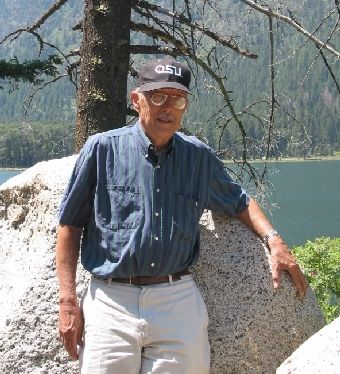
Publisher:
Bonnie King
CONTACT:
Newsroom@Salem-news.com
Advertising:
Adsales@Salem-news.com

~Truth~
~Justice~
~Peace~
TJP
Jan-16-2010 22:05


 TweetFollow @OregonNews
TweetFollow @OregonNews
OSU Geologist Forewarned of Enormous Destructive Potential of Haiti Quake
Salem-News.comYeats is also involved in a research project to create a global fault database that will provide more scientific information about faults around the world.
 Ggeologist Robert Yeats, a professor emeritus at Oregon State University, who said the death toll would be tremendous “if they have an earthquake on this fault that runs through Port-au-Prince” Photo: oregonstate.edu |
(CORVALLIS, Ore.) - An international earthquake expert at Oregon State University suggested just over one week ago that one of the world’s most at-risk locations for a major, destructive earthquake is the fault that runs through Haiti and near Port-au-Prince.
That comment, made during an interview with a reporter for Scientific American, was by geologist Robert Yeats, a professor emeritus at Oregon State University, who said the death toll would be tremendous “if they have an earthquake on this fault that runs through Port-au-Prince” – an observation that is now playing out in the aftermath of the hugely destructive earthquake Tuesday that appears to have killed tens of thousands of people.
The observation also brings home the remarkable advances scientists have made in recent years in understanding the complex, as-yet-unpredictable behavior in the thousands of faults around the world that set the stage for earthquakes, and the socio-economic forces that make some locations more vulnerable than others.
The fault in Haiti, called the Enriquillo-Plaintain Garden Fault, is one place where the North American and Caribbean tectonic plates move past each other, the type of forces that often cause earthquakes. Stresses have been building up on that fault since the last major earthquake on it about 200 years ago. But in this case, the fault was disturbingly close to a major city, and occurred at a shallow depth in an area where poorly constructed masonry buildings were common.
Yeats has written books and numerous professional publications not just on earthquake dynamics but also the ways that cities, nations and individuals can prepare for them, either through well-enforced building codes or personal disaster preparation. The lack of a strong social services network and substandard construction in places like Haiti, Yeats predicted earlier, make it especially vulnerable to any earthquakes that hit.
“The problem is not always just the size of the earthquake, but also the social structure and preparation for it,” Yeats said. “Haiti is one of the poorest nations in the world and that’s reflected in the quality of their housing. And sometimes, even when engineers design buildings properly, the contractors who build them don’t always follow the plans.”
Places such as California, Yeats said, face some geologic concerns similar to those of Haiti but have far more advanced building practices that would help protect against loss of life in a similar tectonic event.
Related video from CBS News: Scientists warned in '08 that Port-au-Prince |
In a new book to be published soon through Cambridge University Press, called “Active Faults of the World,” Yeats also points to some cities such as Kingston, Jamaica; Tehran, Iran; and Istanbul, Turkey as locations that may face similar concerns, with major earthquake risks and many buildings vulnerable to them.
Yeats was also one of the first scientists in the world to begin warning in the mid-1980s that the Pacific Northwest faced major risks from a subduction zone earthquake, very similar to the one that in 2004 caused massive damage and a major tsunami in East Asia that killed nearly 230,000 people. Such an earthquake in the Pacific Northwest was thought to be improbable at that time, but later research by OSU geophysicist Chris Goldfinger and others has demonstrated such events have happened repeatedly in the past several thousand years on the Cascadia Subduction Zone that runs from northern California to British Columbia. The last one occurred Jan. 26, 1700, and the next one could occur almost any time.
Studies of fault zones and earthquake risk have continued to improve in recent decades. And although advances have been made in building codes in the Pacific Northwest, California and other earthquake regions of the United States, OSU researchers in recent years have warned that not enough has been done to prepare for tsunamis, one of the other forces often associated with marine earthquakes. More studies on that are being done at the tsunami wave basin in OSU’s Hinsdale Wave Research Laboratory, the most sophisticated facility of its type in the world.
The university has been involved in some exploratory studies on construction of the first tsunami-resistant public building in the U.S. in Cannon Beach, Ore., a place where people could run to in the few minutes they might have before a tsunami hits following a major subduction zone earthquake. Other OSU research is also under way on ways to make structures more resistant to earthquake shaking with building techniques that may help protect both property and lives.
Yeats is also involved in a research project to create a global fault database that will provide more scientific information about faults around the world. About the OSU College of Science: As one of the largest academic units at OSU, the College of Science has 14 departments and programs, 13 pre-professional programs, and provides the basic science courses essential to the education of every OSU student. Its faculty are international leaders in scientific research.
Articles for January 15, 2010 | Articles for January 16, 2010 | Articles for January 17, 2010




googlec507860f6901db00.html

Terms of Service | Privacy Policy
All comments and messages are approved by people and self promotional links or unacceptable comments are denied.
[Return to Top]
©2025 Salem-News.com. All opinions expressed in this article are those of the author and do not necessarily reflect those of Salem-News.com.